OPIUM CULTIVATION
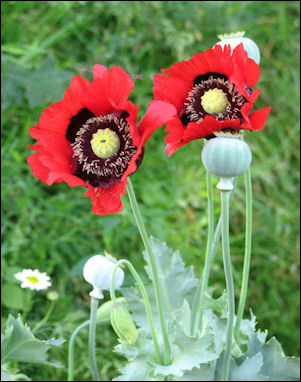
opium poppies Opium is an ideal cash crop and is practical for people living in remote areas with poor roads because it doesn't spoil or rot, the buyers come to them, it is relatively easy to transport over a long distance and it brings a much higher price than conventional cash crops. A pound of opium commands the same price as a quarter ton of rice and is much easier to get to market deal than a bulky crop like potatoes. Some farmers consume opium but many grow it just for money. Those that consume it sometimes get so absorbed smoking it they neglect clothing, health care and even food and the fields that produce the opium.
Richard S. Ehrlich wrote in Asia Sentinel: The opium poppy “is grown mainly by impoverished farmers on small plots in remote regions of the world. It flourishes in dry, warm climates and the vast majority of opium poppies are grown in a narrow, 4,500-mile stretch of mountains extending across southern Asia from Turkey through Pakistan and Laos. Heroin is also increasingly becoming an export from Latin America, notably Colombia." [Source: Richard S. Ehrlich, Asia Sentinel, May 4, 2012]
Opium grows best at an altitude of 3,000 to 6,000 feet in hot areas. It is usually grown in remote valleys and hillsides in mountainous regions because the climate in these areas are often ideal for opium growing. Remote areas are also advantageous because they are often beyond the reach of the government and can be protected by local militias. Authorities are usually not welcome in these areas for obvious reasons and if the do get in they often have difficulty finding and eradicating opium.
In addition to the social costs of opium cultivation — addiction, a lazy, spaced out population — the slash and burn farming techniques used to grow it cause deforestation, severe soil erosion, and other environmental problems. Opium depletes the soil quickly, and consequently it rotated with nutrient-providing crops or grown using slash-and-burn techniques, growing it in one area until nutrients in the soil are depleted and then slashing and burning a new area and growing crops there until the soil is depleted, and repeating the process again.
See Separate Article OPIODS: TYPES, EFFECTS AND DANGERS factsanddetails.com HISTORY AND USE OF OPIUM factsanddetails.com ; HISTORY OF HEROIN factsanddetails.com ; GLOBAL HEROIN TRAFFICKING factsanddetails.com
Websites and Resources: U.S. Drug Enforcement Administration (DEA) justice.gov/dea/concern ; Vaults of Erowid erowid.org ; United Nations Office of Drugs and Crime (UNODC) unodc.org ; Wikipedia article on illegal drug trade Wikipedia ; Frank’s A-to-Z on Drugs talktofrank.com ; Streetdrugs.org streetdrugs.org ; Illegal Drugs, country by country listing, CIA cia.gov/library/publications/the-world-factbook
Books: ““Opium, a History” by Martin Booth (1998, St. Martin's Press); “Opium: A Portrait of the Heavenly Demon” by Barbara Hodgson (Chronicle); Buzzed” by Cynthia Kuhn Ph.D. Scott Swartzwelder, Ph.D., Wilkie Wilson Ph.D. of the Duke University Medical Center (Norton, 2003); “Consuming Habits: Drugs in Anthropology and History” by Goodman, Sharratt and Lovejoy; “Drug War Heresies: Learning from Other Vices, Times and Places” by Robert MacCoun and Peter Reuter (Cambridge University Press).
Opium Production
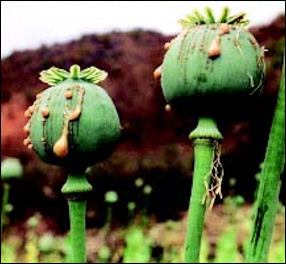
poppies ready to harvest
According to the World Drug Report 2018: From 2016-2017, global opium production jumped by 65 per cent to 10,500 tons, the highest estimate recorded by UNODC since it started monitoring global opium production at the start of the twenty-first century. A marked increase in opium poppy cultivation and gradually improving yields in Afghanistan resulted in opium production there last year reaching 9,000 tons. [Source: World Drug Report 2018,United Nations Office on Drugs and Crime (UNODC), June 26, 2018]
Opium and heroin production is poverty based. Most of the money is made by the smugglers and dealers. Farmers are paid a relative pittance. Between the time it leaves their hands and hits the streets it increases in value about 5,000 times. A typical farmers earns $600 from his crop, barely enough for a farmer to feed his family and handful of animals. Many opium farmers live in villages without electricity or running water.
Opium is grown illegally in mostly in Afghanistan and Myanmar and to a lesser extent Laos, Mexico and Colombia. India is the largest producer of legal opium. Tasmania in Australia and France have also traditionally been major producers. Opium is also grown legally in Turkey, Russia, Romania, Spain and Bulgaria. The French company Francopia at one time produced about a quarter of the world’s total legal opiate requirements, with totals sales of around being about $100 million a year in the 1990s. As of 2020, its subsidiary Euroapi oversaw 10,000 hectares of poppy cultivation, shipped more 120 tons of products and 90 years experience in alkaloid extraction
Opium Growing
Opium poppies are relatively easy to grow and do well in places where that other crops have difficulty taking root. Adaptable plants, they grow well in harsh soils and flourish in places with little water as well as in places with plentiful water supplies as long as heavy rains do not damage the flowers. Opium takes only about two months to reach maturity and farmers usually also grow it with dry-land rice, potatoes, cabbage, or vegetables. Opium can earn farmers far more money than other crops. Opium is a labor intensive crop that requires five times as much labor as wheat. The fields require a lot of weeding and planting and harvesting requires a lot of manpower and time to gather a relatively small amount of opium.
Opium is planted in the autumn and harvested two times: in the spring and early summer. Before planting, opium farmers often taste the soil. If it is sweet (meaning its has a high lime content) it is ideal for growing opium. To prepare the fields, overgrowth is burned off, and the soil is tilled and fertilized In many places planting is a family affair with men poking holes in the soil with dibble sticks while women and children follow behind sowing seeds.
Opium poppies look like young dandelions when they sprout. Just before harvest time the poppies bloom and produce fields of brightly colored flowers. About three months after seeds are planted, the flowers bloom at the tips of greenish, tubular stems. As the petals fall off, they expose an egg-shaped seed pod. Inside this pod is an opaque, milky sap — raw opium in its crudest form.
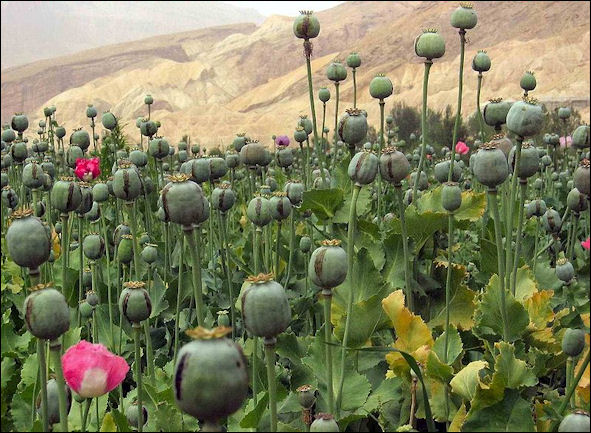
opium in Afghanistan
Opium Harvesting
Opium harvesting begins after the opium poppies have bloomed and their petals have fallen off, leaving behind a swollen pod (also called capsules), which is usually bulbous-shaped but sometimes is elongated or oblong. Opium is derived from the sap or latex produced inside the pod before seeds form. The latex can be white or pink. Ripe seed-laden capsules produce very little or no opium.
Harvesters make a shallow incision in poppy's pod with a sharp blade or needle-like knife, allowing the milky, alkaloid-rich latex to oozes from of tiny tubes in the pod. The opium is allowed to ooze out overnight. Harvesters return the next day to scrape of the latex — now blackened raw opium — with an iron scoop or crescent-shaped tool. The opium is usually scraped off in the morning before the heat of the day make it stick too tightly to the pod. The next day the harvesters return again and keep collecting the raw opium as long as it oozes out of the pod.
Richard S. Ehrlich wrote in Asia Sentinel: The sap is extracted by slitting the pod vertically in parallel strokes with a special curved knife. As the sap oozes out, it turns darker and thicker, forming a brownish-black gum. A farmer collects the gum with a scraping knife, bundles it into bricks, cakes or balls and wraps them in a simple material such as plastic or leaves. [Source: Richard S. Ehrlich, Asia Sentinel, May 4, 2012]
It takes about 2,000 poppy plants (each with a single flower and capsule) to produce to one kilo of opium. Each capsule yields is lanced four or five times. Top quality of the opium gets progressively better until the third lancing and deteriorates after that.
Opium buyers, often tribal leaders, usually come to the farmers to buy their crops. This is very convenient for the farmers. Moving crops such as grains or vegetables to a market can entail a lot of work and money. The brokers usually take a 20 percent cut, sometimes more if they lent the farmers money to grow their crops. The brokers deliver the opium to refining operations. If the market is flooded sometimes they will store the opium until the price rises. Opium retains its potency for a long time and can be stored for years.
Opium Cultivation in Southeast Asia
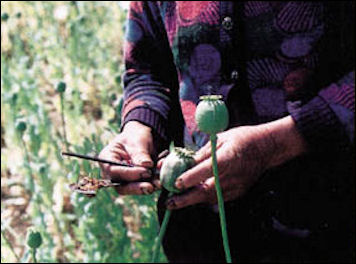
opium harvesting Many of the hill tribes in Thailand, Laos and Myanmar have traditionally produced opium as their main source of income. Chinese traders introduced opium to ethnic minorities in Southeast Asia. The French as well as the English grew it as a cash crop. One forth of the money the French earned in Southeast Asia was generated from opium. The French gave poppy seeds to ethnic minorities in Laos, and gave them advise on how to increase their opium yields. At one point about 90 percent of the Laos's total opium output was produced by the Hmong.
Golden Triangle was the world's largest and most famous opium growing region. Covering an area the size of Nevada and at one time the source of 60 percent of the heroin consumed in United States, it embraces the lovely green mountains and valleys of northern Thailand, western Myanmar (Burma) and northeastern Laos. Most of the opium and heroin is produced in Myanmar and to a lesser extent Laos. The section of the Golden Triangle in Thailand is pretty tame these days. Many former opium-growing areas are now popular trekking areas. Production in Myanmar and Laos are much lower than they used to.
Many minorities live in villages located at 3,000 to 6,000 feet, an altitude perfect for growing opium poppies. Opium and corn are often grown together. Opium is planted in September or October and harvested after the New Year. Corn is planted in May or June and harvested in August or September before opium is planted.
Before planting Hmong farmers taste the soil. If it is sweet (meaning its has a high lime content) then the soil is ideal for growing opium. During planting men march along poking holes in the soils with a dibble stick while women and children follow behind sowing seeds.
The social costs of opium cultivation include addiction, a lazy-spaced population. Some blame the degradation of the soil in the region by slash and burn agriculture on opium. Slash and burn farming techniques used to raise opium have caused heavy deforestation, severe soil erosion, and other environmental problems. Opium depletes the soil quickly, and consequently many of the tribes were nomadic or semi-nomadic — settling on one area to raise an opium crop and then moving on to a new place once the soil was worn out.
Individual Hill Tribes and Opium Production
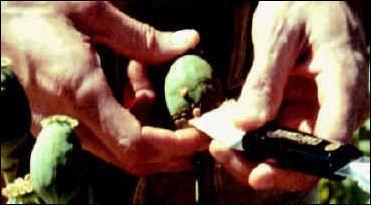
opium harvesting The Yao, Hmong, Akha, Lahu and Lisu in Thailand have traditionally grown rice to eat and opium for medicine and money. Profits are used to buy jewelry, silver bars, rifles, radios, pigs and buffalos.
The Wa, a group of former-head-hunters, now controls some of the major opium growing areas in Myanmar. The Karens live in the lowlands rather than in the mountains. Karen farmers used to be known for growing opium but no consuming it.
The Lisus, Akha and Hmong, have traditionally been the biggest opium producers in the Golden Triangle'. Hmong men in some villages don't do much except sit around the village and get drunk or smoke opium. Akha women are known as being hardworkers while men waste away much of their life smoking opium.
At one point about 90 percent of the Laos's total opium output was produced by the Hmong. The Hmong have long used opium for ritual and medicinal purposes. In the 1970s many Hmong smoked opium on occasion, but not to the point of addiction. It was regarded as acceptable for elderly people to smoke opium and pass away the end of their life in peaceful euphoria but was considered disgraceful for young people to become addicted. National Geographic recounted a story about a Hmong man who ordered his son to stop smoking. The young man tried and failed. The father then told him to kill himself. He did.
Morphine Production
The raw opium scraped from the pods must be prepared or refined into a form that can be smoked or made into morphine. To do this the raw opium is dissolved in water with calcium hydroxide and simmered over a very low heat, producing a brown solution that is filtered to remove impurities such as plant material, soil, and waxes and fibers in the opium pods. The solution is then evaporated slowly over a low heat and the resulting smokable opium is pressed into bricks.
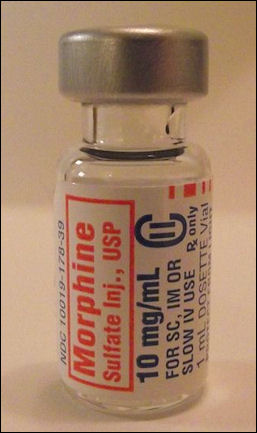
Heroin is made from morphine paste, which in turn is derived from opium. After purchasing the opium from farmers, merchants or brokers transport it to a morphine refinery. "Most traffickers do their morphine refining close to the poppy fields, since compact morphine bricks are much easier to smuggle than bundles of pungent, jelly-like opium," Alfred W. McCoy wrote in “The Politics of Heroin”. Some workers became addicted simply by breathing in the steam and fumes coming from the vats used to simmer the opium gum. One addict who got hooked by working in a morphine paste lab told Newsweek, “When you get home, after the opium wears off, your legs and arms begin to ache, and so you start eating or smoking opium to relieve the pain.”
Richard S. Ehrlich wrote: “At the refinery, which may be little more than a rickety laboratory equipped with oil drums and shrouded in a jungle thicket, the opium is mixed with lime in boiling water. A precipitate of organic waste sinks to the bottom. On the surface a white band of morphine forms. This is drawn off, reheated with ammonia, filtered and boiled again until it is reduced to a brown paste. Poured into molds and dried in the sun, it is now morphine base, which has the consistency of dense modeling clay. Morphine base is smokable in a pipe or ready for further processing into heroin. [Source:Richard S. Ehrlich, Asia Sentinel, May 4, 2012]
Morphine base and crude heroin can be easily manufactured from opium by anyone with some basic knowledge of chemistry and easy-to-obtain materials. To produce morphine, opium is dissolved in water and reacted with lime fertilizer, causing the morphine to precipitate out. This crude morphine is purified further by reacting it again, this time with ammonia, and mechanically filtering it. The resulting morphine base weighs about only 10 percent of the original quantity of opium.
Medical morphine is processed further so it can be injected or swallowed. Pharmaceutical companies extract opium using the Gregory process which involves mashing and cooking the entire poppy excluding the roots and leaves in a diluted acid solution and then isolating alkaloids such as morphine and codeine using the Acid/Base extraction and purification method.
Heroin Production
Making heroin a good laboratory and entails a complicated series of steps. To make heroin, morphine is reacted with acetic anhydride, a chemical also used in the production aspirin. “In his book, Opium A History, Martin Booth wrote: "First, equal quantities of morphine and acetic anhydride are heated in a glass or enamel-lined container. The morphine and the acid combine to form impure diacetylmorphine. Second, water and chloroform are added to the solution to precipitate impurities. The solution is drained and sodium carbonate added to make the heroin solidify and sink. Third, the heroin is filtered out of the sodium carbonate solution with activated charcoal and purified with alcohol. This solution is gently heated to evaporate the alcohol and leave heroin, which may be purified further"
The heroin-making process described in five step involves the following: 1) cooking the morphine for six hours at 85 degrees C with an equivalent weight of acetic anhydride; 2) purifying it with water and hydrochloric acid; 3) adding sodium carbonate to make the particulates settle out, resulting in crude No. 3 brown sugar heroin; 4) heating the heroin in a mixture of alcohol and activated charcoal; and 5) dissolving the heroin in alcohol and precipitating out nearly pure white flakes of heroin when a mixture of ether and hydrochloric acid is added.
The final step is by far the most difficult and dangerous because the ether can easily explode. "In the hands of a careless chemist the volatile ether gas may ignite and produce a violent explosion that can level a clandestine laboratory," McCoy wrote. This process yields a fluffy, white, easy-to-inject powder known as “No. 4 heroin,” or China White, for a while the most sought after heroin type in Western markets. The purity and quality of heroin is determined by the purity of the extracted morphine. Most black heroin has a low purity level because of contaminant left after the refinement of opium into morphine.
Heroin is produced mostly in illegal labs located deep in the remote places. Often they are little more than shacks, set up temporarily in the jungle or mountains, with some modest lab equipment, plastic basins, rubber tubing, bottles of chemicals, picnic table and simple presses. Sometimes they are quickly thrown together to fulfill a single order and can be quickly taken down if authorities are seen in the area.
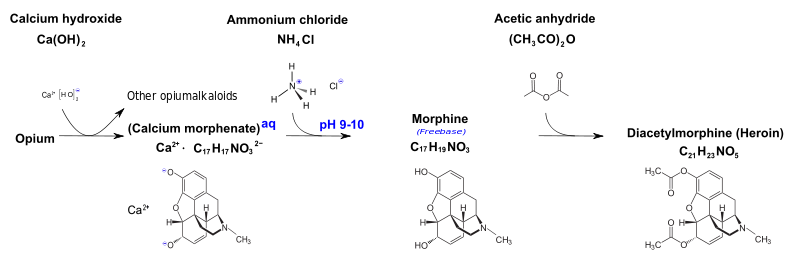
Synthesis of Heroin from Opium
A typical lab keeps the chemicals necessary to produce the morphine and heroin stored in industrial drums. These include calcium hydroxide, needed to cook the raw opium into morphine; hard-to-get acetic anhydride, needed to make heroin; ammonium chloride, which transforms the morphine into low-grade No. 3 heroin; and volatile ether which turns the brown heroin into 90 percent pure No. 4 heroin.
The heroin is processed into one kilo bricks, sometimes stamped with logo of the producer . One kilo of crude morphine paste is produced from 10 to 12 kilos of opium. One kilo of paste can be transformed into one kilo of heroin by treating it with acetic anhydride.
Text Sources: 1) “Buzzed, the Straight Facts About the Most Used and Abused Drugs from Alcohol to Ecstasy” by Cynthia Kuhn, Ph.D., Scott Swartzwelder Ph.D., Wilkie Wilson Ph.D., Duke University Medical Center (W.W. Norton, New York, 2003); 2) National Institute on Drug Abuse, National Institutes of Health, U.S. Department of Health and Human Services; 3) United Nations Office on Drugs and Crime (UNODC) and 4) National Geographic, New York Times, Washington Post, Los Angeles Times, Wikipedia, The Independent, Times of London, The New Yorker, Time, Newsweek, Reuters, Associated Press, AFP, , Lonely Planet Guides, and various books and other publications.
Last updated April 2022
